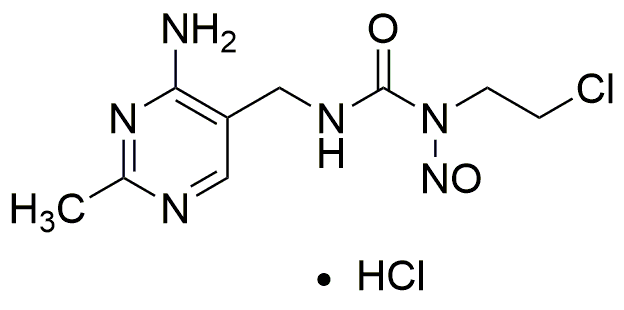Nimustine hydrochloride is widely utilized in research focused on:
- Cancer Treatment: Primarily used in oncology, it serves as a chemotherapeutic agent for treating brain tumors, particularly glioblastomas, offering targeted action against malignant cells.
- Combination Therapy: Often employed in combination with other anticancer drugs, it enhances treatment efficacy and helps overcome drug resistance, providing a more comprehensive approach to cancer management.
- Research in Drug Development: Used in preclinical studies to evaluate new drug formulations and delivery methods, helping researchers understand its pharmacodynamics and optimize therapeutic strategies.
- Veterinary Medicine: Its applications extend to veterinary oncology, where it is used to treat tumors in animals, showcasing its versatility across species.
- Clinical Trials: Frequently involved in clinical trials aimed at improving treatment protocols for various cancers, contributing to advancements in medical research and patient care.
General Information
Properties
Safety and Regulations
Applications
Nimustine hydrochloride is widely utilized in research focused on:
- Cancer Treatment: Primarily used in oncology, it serves as a chemotherapeutic agent for treating brain tumors, particularly glioblastomas, offering targeted action against malignant cells.
- Combination Therapy: Often employed in combination with other anticancer drugs, it enhances treatment efficacy and helps overcome drug resistance, providing a more comprehensive approach to cancer management.
- Research in Drug Development: Used in preclinical studies to evaluate new drug formulations and delivery methods, helping researchers understand its pharmacodynamics and optimize therapeutic strategies.
- Veterinary Medicine: Its applications extend to veterinary oncology, where it is used to treat tumors in animals, showcasing its versatility across species.
- Clinical Trials: Frequently involved in clinical trials aimed at improving treatment protocols for various cancers, contributing to advancements in medical research and patient care.
Documents
Safety Data Sheets (SDS)
The SDS provides comprehensive safety information on handling, storage, and disposal of the product.
Product Specification (PS)
The PS provides a comprehensive breakdown of the product’s properties, including chemical composition, physical state, purity, and storage requirements. It also details acceptable quality ranges and the product's intended applications.
Certificates of Analysis (COA)
Search for Certificates of Analysis (COA) by entering the products Lot Number. Lot and Batch Numbers can be found on a product’s label following the words ‘Lot’ or ‘Batch’.
*Catalog Number
*Lot Number
Certificates Of Origin (COO)
This COO confirms the country where the product was manufactured, and also details the materials and components used in it and whether it is derived from natural, synthetic, or other specific sources. This certificate may be required for customs, trade, and regulatory compliance.
*Catalog Number
*Lot Number
Safety Data Sheets (SDS)
The SDS provides comprehensive safety information on handling, storage, and disposal of the product.
DownloadProduct Specification (PS)
The PS provides a comprehensive breakdown of the product’s properties, including chemical composition, physical state, purity, and storage requirements. It also details acceptable quality ranges and the product's intended applications.
DownloadCertificates of Analysis (COA)
Search for Certificates of Analysis (COA) by entering the products Lot Number. Lot and Batch Numbers can be found on a product’s label following the words ‘Lot’ or ‘Batch’.
*Catalog Number
*Lot Number
Certificates Of Origin (COO)
This COO confirms the country where the product was manufactured, and also details the materials and components used in it and whether it is derived from natural, synthetic, or other specific sources. This certificate may be required for customs, trade, and regulatory compliance.


